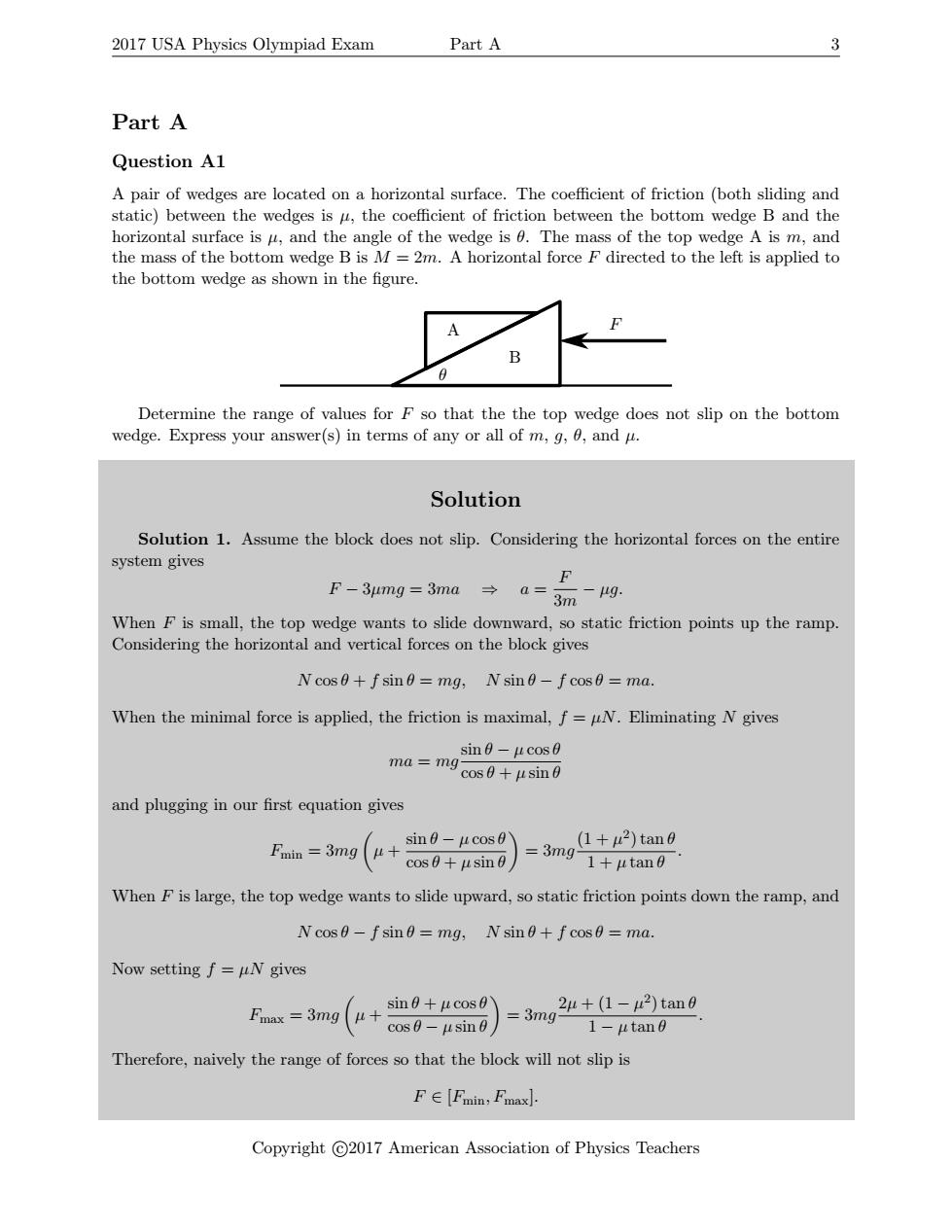正在加载图片...

2017 USA Physics Olympiad Exam Part A 3 Part A Question Al A pair of wedges are located on a horizontal surface.The coefficient of friction (both sliding and static)between the wedges is u,the coefficient of friction between the bottom wedge B and the horizontal surface is u,and the angle of the wedge is 0.The mass of the top wedge A is m,and the mass of the bottom wedge B is M=2m.A horizontal force F directed to the left is applied to the bottom wedge as shown in the figure. A B Determine the range of values for F so that the the top wedge does not slip on the bottom wedge.Express your answer(s)in terms of any or all of m,g,0,and u. Solution Solution 1.Assume the block does not slip.Considering the horizontal forces on the entire system gives F-3mg=3ma→a=3 F -ug. When F is small,the top wedge wants to slide downward,so static friction points up the ramp. Considering the horizontal and vertical forces on the block gives N cos0+f sin0 mg,Nsin0-f cos0 ma. When the minimal force is applied,the friction is maximal,f=uN.Eliminating N gives sin9-μcos0 ma mg- cos0+usin0 and plugging in our first equation gives Fmin =3mg sin0-μcos0\ u+ cos0+μsin0 =3mg (1+μ2)tan0 1+μtan9 When F is large,the top wedge wants to slide upward,so static friction points down the ramp,and N cos0-f sin0 mg, N sin0+f cos0 ma. Now setting f=uN gives Fmax =3mg sin 6+u cos 2μ+(1-r2)tan0 cos0-μsinθ =3mg 1-μtan0 Therefore,naively the range of forces so that the block will not slip is F∈[Fmin,Fmax: Copyright C2017 American Association of Physics Teachers2017 USA Physics Olympiad Exam Part A 3 Part A Question A1 A pair of wedges are located on a horizontal surface. The coefficient of friction (both sliding and static) between the wedges is µ, the coefficient of friction between the bottom wedge B and the horizontal surface is µ, and the angle of the wedge is θ. The mass of the top wedge A is m, and the mass of the bottom wedge B is M = 2m. A horizontal force F directed to the left is applied to the bottom wedge as shown in the figure. B A F θ Determine the range of values for F so that the the top wedge does not slip on the bottom wedge. Express your answer(s) in terms of any or all of m, g, θ, and µ. Solution Solution 1. Assume the block does not slip. Considering the horizontal forces on the entire system gives F − 3µmg = 3ma ⇒ a = F 3m − µg. When F is small, the top wedge wants to slide downward, so static friction points up the ramp. Considering the horizontal and vertical forces on the block gives N cos θ + f sin θ = mg, N sin θ − f cos θ = ma. When the minimal force is applied, the friction is maximal, f = µN. Eliminating N gives ma = mg sin θ − µ cos θ cos θ + µ sin θ and plugging in our first equation gives Fmin = 3mg µ + sin θ − µ cos θ cos θ + µ sin θ = 3mg (1 + µ 2 ) tan θ 1 + µ tan θ . When F is large, the top wedge wants to slide upward, so static friction points down the ramp, and N cos θ − f sin θ = mg, N sin θ + f cos θ = ma. Now setting f = µN gives Fmax = 3mg µ + sin θ + µ cos θ cos θ − µ sin θ = 3mg 2µ + (1 − µ 2 ) tan θ 1 − µ tan θ . Therefore, naively the range of forces so that the block will not slip is F ∈ [Fmin, Fmax]. Copyright c 2017 American Association of Physics Teachers